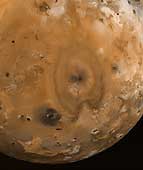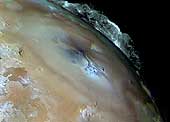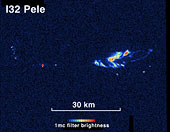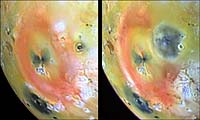
Left: Volcano Pele, named after the legendary Hawaiian volcano goddess, has a heart formed from volcanic ejecta.
|
Table of Contents |
|
Pele Volcano & Pillan Patera
|
|
Parent Planet |
|
Io Science |

|
| Eruption of Pele. [ more ] |
The vent region of Pele has an intense high-temperature hot spot that is remarkably steady, unlike lava flows that erupt in pulses, spread out over large areas, and then cool over time. This leads scientists to hypothesize that there must be an extremely active lava lake at Pele that constantly exposes fresh lava. Galileo's camera snapped a close-up picture showing part of the volcano glowing in the dark. Hot lava, at most a few minutes old, forms a thin, curving line more than six miles (10 kilometers) long and up to 150 feet (50 meters) wide. Scientists believe this line is glowing liquid lava exposed as the solidifying crust breaks up along the caldera's walls. This is similar to the behavior of active lava lakes in Hawaii, although Pele's lava lake is a hundred times larger.
 Pele's Glow
Pele's Glow
Brightly glowing lava from the volcano Pele is seen in this image taken by
NASA's Galileo spacecraft as it receded from its close flyby of Jupiter's
moon Io. The image at left shows Io's surface in
approximately true color, centered on the large red ring of sulfur that was
deposited by Pele's plume. A false color infrared composite of the same region is
shown on the right. The dark red dot at the center of the ring
is the glow of hot lava at the heart of the volcano.
Temperatures up to 1,027 degrees celsius have
been previously measured for Pele's lava. The glow is bright enough to be
imaged in daylight, allowing scientists to precisely pinpoint the eruptive
center.
 Io's Pele Glowing in the Dark
Io's Pele Glowing in the Dark
In this high-resolution view from the Galileo spacecraft, the Pele hot spot
shows a complex pattern of areas glowing in the dark, including areas likely
to be fresh overturning of a lava lake's crust. This picture reveals details
down to 60 meters (200 feet) in length. Red indicates the most intense
combination of temperature and area; blue indicates cooler materials or
smaller patches of hot materials.
Scientists believe the Pele hot spot has a lava lake inside a volcanic crater
or caldera, where cooled crust of the lava lake is breaking up against the
wall and hotter lava appears from underneath.
Pillan Patera

|
| Changes in Pillan Pateria. [ more ] |
The Galileo spacecraft indicate that the lava at Pillan Patera exceeded 1,700 degrees kelvin (2,600 degrees Fahrenheit) and may have reached 2,000 degrees kelvin (3,140 degrees Fahrenheit). The hottest eruptions on Earth today reach temperatures of about 1,500 kelvin (2,240 degrees Fahrenheit), but hotter lava erupted billions of years ago.